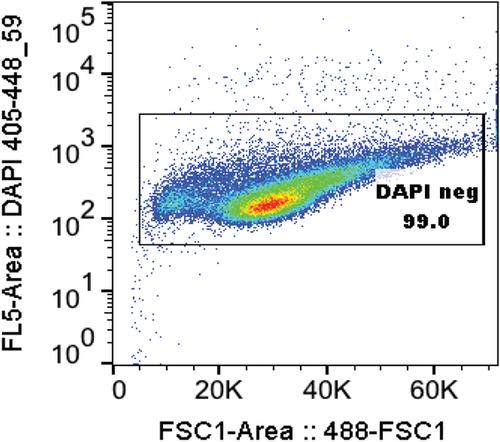下载PDF
{"title":"FACS法测定线粒体自噬的灵敏定量mKeima试验","authors":"Chunxin Wang","doi":"10.1002/cpcb.99","DOIUrl":null,"url":null,"abstract":"<p>Mitophagy is a selective autophagy process that specifically removes damaged mitochondria via general autophagy. The two major recessive Parkinson's disease genes PINK1 and Parkin play essential roles in mitophagy initiation, increasing the interest in mitophagy in both basic and translational research over the past 10 years. Initially, mitophagy was measured by the loss of mitochondria either through confocal imaging or immunoblot of mitochondrial proteins such as Tom20 or COXII. Confocal imaging of mitochondria DNA loss via anti-DNA staining is another option. All of these methods, which take considerable effort and labor, are not sensitive enough to detect early stages of mitophagy with unambiguous objectivity. The mKeima assay can be used for both confocal imaging and FACS analysis to provide a thorough picture of mitophagy with a wide dynamic range. The Keima fluorophore has bimodal excitation under neutral and acidic pH conditions. Thus, when Keima is targeted to mitochondria it can accurately reveal the formation of mitolysosomes. Here the author briefly describes the origin and history of mKeima and how it is adapted to measure mitophagy. The author presents detailed protocols for making stable cell lines for optimized mitophagy detection and discuss many parameters that might affect the assay. A troubleshooting section is also provided to discuss possible pitfalls to improve reproducibility and sensitivity of the assay. © 2019 The Authors.</p><p>This article was corrected on 20 August 2022. See the end of the full text for details.</p><p><b>Basic Protocol 1</b>: Making stable lines expressing mito-mKeima and YFP-Parkin</p><p><b>Support Protocol</b>: Retrovirus/lentivirus infection</p><p><b>Basic Protocol 2</b>: FACS analysis of mitophagy</p>","PeriodicalId":40051,"journal":{"name":"Current Protocols in Cell Biology","volume":"86 1","pages":""},"PeriodicalIF":0.0000,"publicationDate":"2019-12-26","publicationTypes":"Journal Article","fieldsOfStudy":null,"isOpenAccess":false,"openAccessPdf":"https://sci-hub-pdf.com/10.1002/cpcb.99","citationCount":"11","resultStr":"{\"title\":\"A Sensitive and Quantitative mKeima Assay for Mitophagy via FACS\",\"authors\":\"Chunxin Wang\",\"doi\":\"10.1002/cpcb.99\",\"DOIUrl\":null,\"url\":null,\"abstract\":\"<p>Mitophagy is a selective autophagy process that specifically removes damaged mitochondria via general autophagy. The two major recessive Parkinson's disease genes PINK1 and Parkin play essential roles in mitophagy initiation, increasing the interest in mitophagy in both basic and translational research over the past 10 years. Initially, mitophagy was measured by the loss of mitochondria either through confocal imaging or immunoblot of mitochondrial proteins such as Tom20 or COXII. Confocal imaging of mitochondria DNA loss via anti-DNA staining is another option. All of these methods, which take considerable effort and labor, are not sensitive enough to detect early stages of mitophagy with unambiguous objectivity. The mKeima assay can be used for both confocal imaging and FACS analysis to provide a thorough picture of mitophagy with a wide dynamic range. The Keima fluorophore has bimodal excitation under neutral and acidic pH conditions. Thus, when Keima is targeted to mitochondria it can accurately reveal the formation of mitolysosomes. Here the author briefly describes the origin and history of mKeima and how it is adapted to measure mitophagy. The author presents detailed protocols for making stable cell lines for optimized mitophagy detection and discuss many parameters that might affect the assay. A troubleshooting section is also provided to discuss possible pitfalls to improve reproducibility and sensitivity of the assay. © 2019 The Authors.</p><p>This article was corrected on 20 August 2022. See the end of the full text for details.</p><p><b>Basic Protocol 1</b>: Making stable lines expressing mito-mKeima and YFP-Parkin</p><p><b>Support Protocol</b>: Retrovirus/lentivirus infection</p><p><b>Basic Protocol 2</b>: FACS analysis of mitophagy</p>\",\"PeriodicalId\":40051,\"journal\":{\"name\":\"Current Protocols in Cell Biology\",\"volume\":\"86 1\",\"pages\":\"\"},\"PeriodicalIF\":0.0000,\"publicationDate\":\"2019-12-26\",\"publicationTypes\":\"Journal Article\",\"fieldsOfStudy\":null,\"isOpenAccess\":false,\"openAccessPdf\":\"https://sci-hub-pdf.com/10.1002/cpcb.99\",\"citationCount\":\"11\",\"resultStr\":null,\"platform\":\"Semanticscholar\",\"paperid\":null,\"PeriodicalName\":\"Current Protocols in Cell Biology\",\"FirstCategoryId\":\"1085\",\"ListUrlMain\":\"https://onlinelibrary.wiley.com/doi/10.1002/cpcb.99\",\"RegionNum\":0,\"RegionCategory\":null,\"ArticlePicture\":[],\"TitleCN\":null,\"AbstractTextCN\":null,\"PMCID\":null,\"EPubDate\":\"\",\"PubModel\":\"\",\"JCR\":\"Q3\",\"JCRName\":\"Biochemistry, Genetics and Molecular Biology\",\"Score\":null,\"Total\":0}","platform":"Semanticscholar","paperid":null,"PeriodicalName":"Current Protocols in Cell Biology","FirstCategoryId":"1085","ListUrlMain":"https://onlinelibrary.wiley.com/doi/10.1002/cpcb.99","RegionNum":0,"RegionCategory":null,"ArticlePicture":[],"TitleCN":null,"AbstractTextCN":null,"PMCID":null,"EPubDate":"","PubModel":"","JCR":"Q3","JCRName":"Biochemistry, Genetics and Molecular Biology","Score":null,"Total":0}
引用次数: 11
引用
批量引用


 求助内容:
求助内容: 应助结果提醒方式:
应助结果提醒方式:


